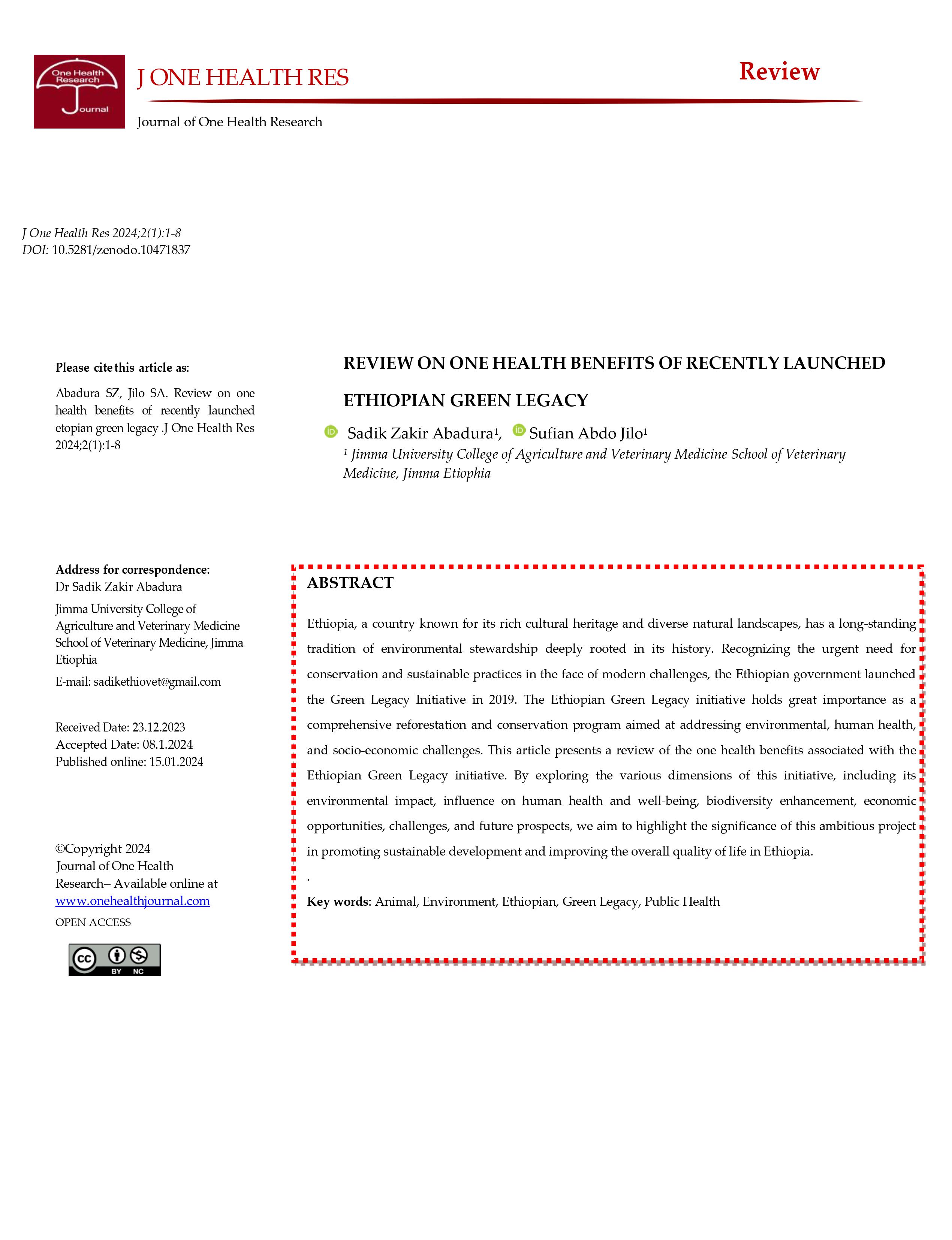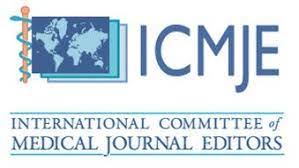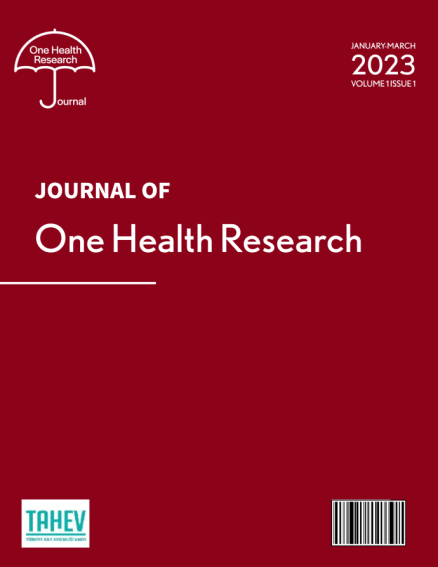REVIEW ON ONE HEALTH BENEFITS OF RECENTLY LAUNCHED ETHIOPIAN GREEN LEGACY
DOI:
https://doi.org/10.5281/zenodo.10471837Özet
Ethiopia, a country known for its rich cultural heritage and diverse natural landscapes, has a long-standing tradition of environmental stewardship deeply rooted in its history. Recognizing the urgent need for conservation and sustainable practices in the face of modern challenges, the Ethiopian government launched the Green Legacy Initiative in 2019. The Ethiopian Green Legacy initiative holds great importance as a comprehensive reforestation and conservation program aimed at addressing environmental, human health, and socio-economic challenges. This article presents a review of the one health benefits associated with the Ethiopian Green Legacy initiative. By exploring the various dimensions of this initiative, including its environmental impact, influence on human health and well-being, biodiversity enhancement, economic opportunities, challenges, and future prospects, we aim to highlight the significance of this ambitious project in promoting sustainable development and improving the overall quality of life in Ethiopia.
.
Referanslar
Aklilu A, Desalegn W, Mesfin K and Negash T (2013). Climate change impacts on Pastoral
Women in Ethiopia:Some evidences from the Southern lowlands. PHE Ethiopia Consortium.1-6p.
Al-Thani, H., Koç, M. and Isaifan, R.J., 2018. A review on the direct effect of particulate atmospheric pollution on materials and its mitigation for sustainable cities and societies. Environmental science and pollution research, 25, pp.27839-27857.
Avise, J.C. and Avise, J.C., 2017. Mammalogy. From Aardvarks to Zooxanthellae: The Definitive Lyrical Guide to Natures Ways, pp.1-23.
Baumgard, L.H., Rhoads, R.P., Rhoads, M.L., Gabler, N.K., Ross, J.W., Keating, A.F., Boddicker, R.L., Lenka, S. and Sejian, V., 2012. Impact of climate change on livestock production. Environmental stress and amelioration in livestock production, pp.413-468.
Bennett, J.E., Stevens, G.A., Mathers, C.D., Bonita, R., Rehm, J., Kruk, M.E., Riley, L.M., Dain, K., Kengne, A.P., Chalkidou, K. and Beagley, J., 2018. NCD Countdown 2030: worldwide trends in non-communicable disease mortality and progress towards Sustainable Development Goal target 3.4. The lancet, 392(10152), pp.1072-1088.
Berendt F., Fortin M., Jaeger D. & Schweier J. (2017). How climate change will affect
forest composition and forest operations in BaDENWÜRTTemberg a GIS-based case study approach. Forests. 8(298), 1 -22
Bertoni, G., Trevisi, E., Houdijk, J., Calamari, L. and Athanasiadou, S., 2016. Welfare Is Affected by Nutrition Through Health, Especially Immune Function and Inflammation. Nutrition and the welfare of farm animals, pp.85-113.
Beyene, Fekadu, BokuTache, Gadissa Tesfaye, Jabessa Teshome and Medihanit Abebe
(2016). Assessment of Customary Land Administration and Natural Resources
Managementin the Pastoral areas ofthe Oromia Regional State. Bejinlaw review, 12(4), 1-90.
CDC. History of Ebola Virus Disease (EVD) Outbreaks [Internet]. 2022. Available from: https://www.cdc.gov/vhf/ebola/history/chronology.html.
Dibaba, Assefa Tefera. "Oromo orature: An ecopoetic approach, theory and practice (Oromia/Ethiopia, Northeast Africa)." Humanities 9, no. 2 (2020): 28.
Dixon MA, Dar OA, Heymann DL (2014) Emerging infectious diseases: opportunities at the humananimalenvironment interface. Veterinary Record 174:546551
EEPA. (2019). Ethiopias Climate Resilient Green Economy Strategy Agriculture: National AdaptationPlan(NAP)ImplementationRoadmap. Environment, Forest andClimate Change Commission, August. http://www.uncsd2012.org/content/documents/287CRGE Ethiopia Green Economy_Brochure.pdf
Everard, M., 2009. The business of biodiversity. WIT Press.
FDRE. (2015). Intended Nationally Determined Contribution (INDC) of the Federal Democratic Republic of Ethiopia. http://www4.unfccc.int/submissions/INDC/Published
Documents/Ethiopia/1/INDC- Ethiopia-100615.pdf
Fischer, J., Lindenmayer, D.B. and Manning, A.D., 2006. Biodiversity, ecosystem function, and resilience: ten guiding principles for commodity production landscapes. Frontiers in Ecology and the Environment, 4(2), pp.80-86.
Franck Cesar Jean; Bouley Timothy; Karesh WB. LGFG. MCCPCASRM.
B. Operational framework for strengthening human, animal and
environmental public health systems at their interface Washington, D.C.:
World Bank Group. [Internet]. 2018. Available from: https://documents.
worldbank.org/en/publication/documents-reports/documentdetail/
1517234402168/operational-framework-for-strengthening-humananimal-and-environmental-public-health-systems-at-their-interface
Gandile, A.U., Tessema, S.M. and Nake, F.M., 2017. Biodiversity conservation using the indigenous knowledge system: The priority agenda in the case of Zeyse, Zergula and Ganta communities in Gamo Gofa Zone (Southern Ethiopia). International Journal of Biodiversity and Conservation, 9(6), pp.167-182.
Haines-Young, R. and Potschin, M., 2010. The links between biodiversity, ecosystem services and human well-being. Ecosystem Ecology: a new synthesis, 1, pp.110-139.
Hume, D.A., Whitelaw, C.B.A. and Archibald, A.L., 2011. The future of animal production: improving productivity and sustainability. The Journal of Agricultural Science, 149(S1), pp.9-16.
Ibrahim, M., Schlonvoigt, A., Camargo, J.C. and Souza, M., 2001. Multi-strata silvipastoral systems for increasing productivity and conservation of natural resources in Central America.
Jafari, M., Tahmoures, M., Ehteram, M., Ghorbani, M. and Panahi, F., 2022. Slope stabilization methods using biological and biomechanical measures. In Soil erosion control in drylands (pp. 445-647). Cham: Springer International Publishing.
Kondo, M.C., Fluehr, J.M., McKeon, T. and Branas, C.C., 2018. Urban green space and its impact on human health. International journal of environmental research and public health, 15(3), p.445.
Machalaba CC, Salerno RH, Barton Behravesh C, Benigno S, Berthe FCJ, Chungong S, et al. Institutionalizing One Health: From Assessment to Action. Heal Secur. 2018;16(S1):S37-43.
Madhav, S., Ahamad, A., Singh, A.K., Kushawaha, J., Chauhan, J.S., Sharma, S. and Singh, P., 2020. Water pollutants: sources and impact on the environment and human health. Sensors in water pollutants monitoring: Role of material, pp.43-62.
Maru, Y., Gebrekirstos, A. and Haile, G., 2020. Indigenous ways of environmental protection in Gedeo community, Southern Ethiopia: A socio-ecological perspective. Cogent Food & Agriculture, 6(1), p.1766732.
Mishra, R.K., 2023. Fresh water availability and its global challenge. British Journal of Multidisciplinary and Advanced Studies, 4(3), pp.1-78.
Moges, Y., Haile, M. and Livingstone, J., 2021. Integration of forest landscape restoration in.
Mori, J., Ferrini, F. and Saebo, A., 2018. Air pollution mitigation by urban greening. Italus Hortus, 25(1), pp.13-22.
Oldekop, J.A., Holmes, G., Harris, W.E. and Evans, K.L., 2016. A global assessment of the social and conservation outcomes of protected areas. Conservation Biology, 30(1), pp.133-141.
Polsky, L. and von Keyserlingk, M.A., 2017. Invited review: Effects of heat stress on dairy cattle welfare. Journal of dairy science, 100(11), pp.8645-8657.
Sejian, V., Bhatta, R., Gaughan, J.B., Dunshea, F.R. and Lacetera, N., 2018. Adaptation of animals to heat stress. Animal, 12(s2), pp.s431-s444.
Sene, J., Napper, K., Meeker, L. and Fabara, M.M., 2023. Enhancing Environmental Education Opportunities in the Borderlands: A Consulting Project for Borderlands Restoration Network by JKLM Sustainability Consulting (MSUS).
Shiferaw, W. (2020). Climate-Smart Agricultural Practices in Ethiopia: Implications of Mitigation ofGreenhouse Gas Emissions: A Review Paper.
Sieghardt, M., Mursch-Radlgruber, E., Paoletti, E., Couenberg, E., Dimitrakopoulus, A., Rego, F., Hatzistathis, A. and Randrup, T.B., 2005. The abiotic urban environment: impact of urban growing conditions on urban vegetation. Urban forests and trees: a reference book, pp.281-323.
Soumya, N.P., Banerjee, R., Banerjee, M., Mondal, S., Babu, R.L., Hoque, M., Reddy, I.J., Nandi, S., Gupta, P.S.P. and Agarwal, P.K., 2022. Climate change impact on livestock production. In Emerging Issues in Climate Smart Livestock Production (pp. 109-148). Academic Press.
swamy Prabuddha, H.R., Singh, M.P., Purushotham, P., Divakara, B.N., Manohara, T.N., Chandrashekar, B.S., Ravi, N., Reddy, N.M. and Singh, O., 2023. Forestry Interventions and Groundwater Recharge, Sediment Control and Carbon Sequestration in the Krishna River Basin. Open Journal of Forestry, 13(4), pp.368-395.
Wassie, S.B., 2020. Natural resource degradation tendencies in Ethiopia: a review. Environmental systems research, 9(1), pp.1-29.
Webster, A.J., 2001. Farm animal welfare: the five freedoms and the free market. The veterinary journal, 161(3), pp.229-237.
World Health Organization, 2016. Protecting surface water for health: identifying, assessing and managing drinking-water quality risks in surface-water catchments.
ZegeyeHaileab. (2017). Major drivers and consequences of deforestation in Ethiopia: implications forforest conservation. AsianJournal ofScience andTechnology. 8(8). 5166 5175.
Zeleke, A. and Vidal, A., 2020. Contributing to scaling up forest landscape restoration in Ethiopia. Restoration Diagnostic Applied in Sodo Guragie (SNNPR) and Meket (Amhara Region) Woredas.

Yayınlanmış
Nasıl Atıf Yapılır
Sayı
Bölüm
Lisans
Telif Hakkı (c) 2024 Journal of One Health Research

Bu çalışma Creative Commons Attribution 4.0 International License ile lisanslanmıştır.




